Blue Libra is an indie casual real-time space strategy game, that is available for many platforms. Orator Games (the game developers) have versions of their game for the Windows PC, MacOS, Linux, iPad, iPhone and Android.
I had Blue Libra in my to-check list for quite some time. My original plan was to do a first impressions article, but after playing for a while (the windows pc version) I decided that I had experienced a great deal of what the game has to offer. I realized that I had enough material and gameplay hours to actually review the game. This happened for two reasons. First of all the game is not very big, in terms of continuous gaming hours. The campaign can be finished in about 2-3 hours or so, in normal difficulty. The other reason that made me decide to go for a review instead was that I became addicted to the game very fast, and so, when that happens (not so often or so immediately as you might expect) it’s much easier to review a game.
Blue Libra’s Gameplay
Blue Libra’s gameplay consists of conquering all the planets, space stations and defense platforms available to you in a given scenario. To achieve that, your main concern is to build as many spaceships as possible, and as fast as you can, before your opponent starts to overwhelm you. And you must achieve all of this every time by starting only with your mothership (called Libra), according to the story the last remnant of your kind after your homeworld has been invaded by the Garian.
In each mission your objective is to wipe out all enemy forces, being those planets, space stations, defense platforms and all kinds of enemy ships. To do that you need to build different kinds of spaceships, each one serving a different purpose.
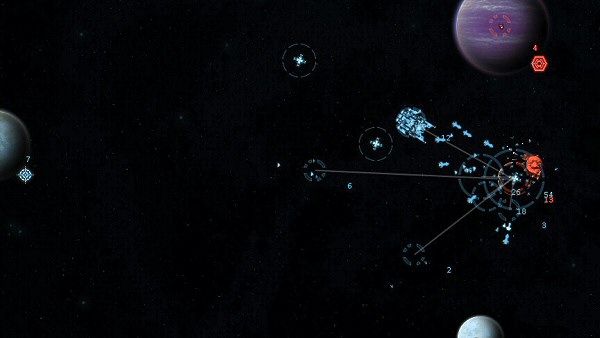
Blue Libra: Space Combat
So, as you’re probably already grasping, Blue Libra is a highly paced RTS game, so prepare yourself for a click fest.
Blue Libra offers a campaign mode and a skirmish mode. The campaign consists of a total of 19 missions with one of those being a tutorial mission. When you’re through with that skirmish scenarios are a good alternative. Skirmishes are randomly generated every time you play, so, you get the chance to play a unique scenario every time you want to give it a go.
So, is it all about tactics? Where is the strategy?
With so many battling elements you may start to wonder by now where are the strategy elements of Blue Libra? After all this is a real-time strategy game right? Well, besides controlling all the tactical aspects of the game like ordering your fleets to go somewhere, deciding to attack in numbers or to split the fleets and attack multiple targets, risking the use, or not, of your mothership in big battles, charging or retreating, you also have some higher-level decisions to make.
After each mission you accumulate credits. With these credits you can buy upgrades, that in a way are like technology enhancements. These upgrades come in three areas: Economy, Warfare and Tactics. One example of an economy upgrade is “capture planets and space stations 20% quicker”. An example of Warfare upgrade would be “Improved mothership (Libra) defense” and an example of a tactics upgrade would be “All ships gain evasive ability”. So, deciding which upgrades to undertake between missions are strategic decisions.
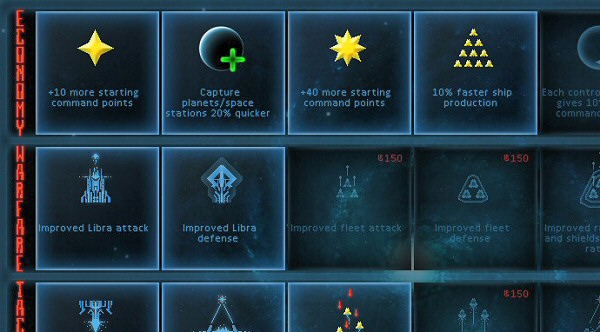
Blue Libra: Upgrades
During each mission you also have to make decisions that are not strictly related with combat. For instance you must decide which planet (or planets), or stations you want to capture next, which spaceships should you build next (should you build more fighters or capital ships?) Or perhaps you should build a mix of spaceships types in one planet and another mix on another planet because of their strategic locations. These “what-to-build-next” actions are all strategic decisions, so, there’s plenty of strategy in Blue Libra alright.
Some of these decisions are leisured-paced (tech upgrades), others will not enjoy of your careful thinking since you have to be quick making these decisions while you handle all the game’s frenetic real-time tactical mechanics. So, in a sense, Blue Libra offers a combination of real-time tactics and real-time strategy all in a (very) high-paced gameplay.
Some words on controls and about the UI
Learning to play Blue Libra is easy. You will understand much of what you need to do in the game right in the first tutorial mission. The rest you will, eventually, pick up mission after mission. And I say eventually because there is no game manual and some things are not so obvious at first. But overall things in Blue Libra are intuitive, and controls is such an example. Everything in Blue Libra is achieved with mouse control, probably 95% of which with your left-mouse button. Occasionally you need to zoom-in or out in bigger maps with your mouse wheel, or you will right-click to pan the map around, but almost everything you do, you do with the left mouse button.
It’s really easy to get the hand of the controls and they’re also great fun to master, especially the way you split fleets by “splitting” them with a “mouse-slash” movement. Or setting a course for a fleet by “drawing” a route on a freehand fashion. The UI is minimal and for the most part intuitive, except on understanding the ship’s characteristics, since the ship’s descriptions are very brief and no tool tips are provided. Eventually you will understand what all those icons stand for but it is not that immediate. After a half of dozen missions you’ll probably have it all figure out.
A word on replayability and the lack of multiplayer
Blue Libra offers a short gameplay experience. The campaign can offer you probably between 2 to 8 hours of play max, depending on the difficulty you play on, and if you decide or not to replay the campaign on tougher difficulties for the sake of challenge. I took around 3 to 4 hours to finish the campaign in normal difficulty (there are three levels to choose from), but those were not really 4 hours of continuous play. I had to replay 2 or 3 missions a couple of times, but overall I was winning every mission in the first try.
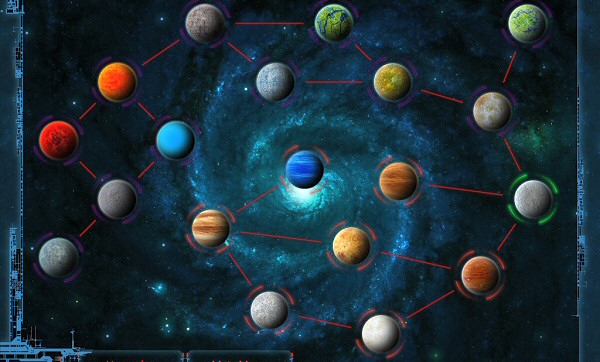
Blue Libra: Campaign Missions
Then I played a couple of skirmish scenarios (which surely help increase replayability substantially) on hard to get a feeling of playing standalone missions. I was faced with a good challenge there and was not able to win so easily that’s for sure. The campaign however didn’t pose much of a challenge (in normal difficulty at least) but it was enough to keep me addicted all the way through. The lack of multiplayer options hinder BL’s full potential however. I’m sure the devs must have thought about this. Multiplayer would definitely open the door for even greater game replayability.
A few more scattered thoughts
Graphics are minimal, so, don’t expect any spaceship fancy rendering or anything like that. Fighters are no more than little dots that look like swarms of bees, while capital ships aren’t more than small blobs.
Then there are interesting little details like bombers and missile bombers staying in the back doing what they do (bombing), while destroyers and other attack ships go forward and engage the enemy head on. Although these are interesting little details you can’t micromanage this, unfortunately. You can move fleets, split them, order them to attack, retreat or order them to capture planets or stations, but that’s really about it.
Some sounds are very cool like the blasting effect of capital ships or the mega zapping effect of dreadnoughts. The remaining sounds are basic but sufficient.
It’s worth noting also that there’s a good variety of spaceships available for construction, each one serving a different function, and with specific requirements. One type is more efficient against shields, another does more damage against capital ships or more damage against fighters, for example. You have three types of fighter ships, you have destroyers, medium-sized capital ships, battleships and dreadnoughts.
Bottom Line
Both the small campaign and the lack of multiplayer hinder the game’s true potential, although this is moderately mitigated by the skirmish gameplay mode, that allows you to play a unique game every time.
If you’re looking for a fast paced strategy game to fill-in a quarter of an hour (or half an hour) while you make a context switch from work or when you wait at the doctor’s, then Blue Libra is the perfect game for you. If on the other hand you’re looking for a deeper and more leisury-paced strategy game then probably you could skip this one. In any case Blue Libra is very cheap (<5$), so that is worth considering if you’re undecided to buy it or not.
In any case, Blue Libra is a small, yet fun, and very addictive space game, that can give you some hours of good entertainment.
Blue Libra is available for PC Windows, MacOS and Linux for 4,99$, or 3,99 Euro + VAT (also on Desura for Windows and Linux). The iPad version costs $3.99 and the iPhone and Android versions cost ($1.99). There’s a demo available for all platforms (except Android) in the game’s official website.
|
Space Sector score: 7.0/10
good
|
|---|
| The Good: – Cheap – Fun and addictive gameplay – Intuitive user interface – Low learning curve (easy and fast to learn to play) – Good variety of spaceships available for construction – Good for casual and short game sessions |
| The Bad: – No multiplayer options hinders replayability and game’s true potential – Campaign is short, game can be finished in a few hours. Limited experience – Bad for gamers that want a deeper and more leisury-paced strategy experience |
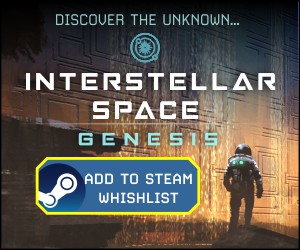
6 Comments
Related Articles:
- Orator Games Released Blue Libra 2 for PC, Mac and iOS
- Hey, Nice Sci-Fi Titles on the IndieFort Championship Bundle
- How Simple Can a Space Strategy Game Be? Solstice – First Impressions
- Gemini Wars Preview
- Space Pirates and Zombies (SPAZ) BETA Review (version 0.9.0005)

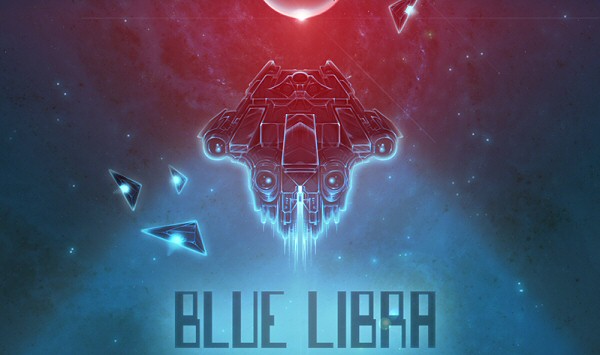
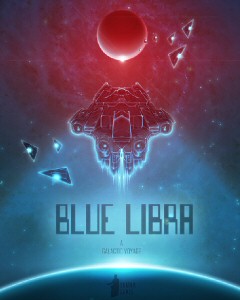
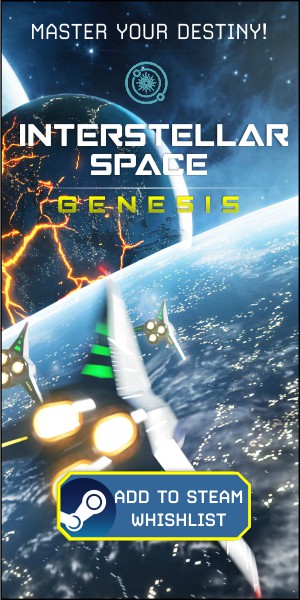





Looking at the video it feels a bit like NanoWar meets Sins of Solar Empire. For $5 im not even going to bother with the demo, I want it allready (as a time out between my 48 hour SSE campaigns :)
:)
It also has a few sprinkles of Homeworld, but normally I avoid doing parallels in my reviews if possible.
SSE you mean SoaSE? (Sins?) I ask because Sins has no campaign ;)
No campaign in SoaSE.. technically true.. but it has when I play it.
I got Blue Libra and it’s very nice so far. Nicely evolved and enhanced node war (free move with paths.. yeah!)
Yes, I was just teasing you about the campaign.
Yes, the free move paths are really cool. If fully explored that could even be used for defining patrolling routes, but as the game is so fast-paced there’s really no time to think on that kind of thing.
TotalBiscuit did a review on this a few weeks back like 2 months ago i think? He said the game is fun but the controls are a bit hard to get used to since using the mouse to cut the squads and such.
I found it easy to master the controls. My only complaint was for lack of help or documentation on how to split fleets (I figured that one myself by accident). The remaining operations: move fleets, move Libra mothership, order attack, create a route, zoom, move the map around are all very simple operations.